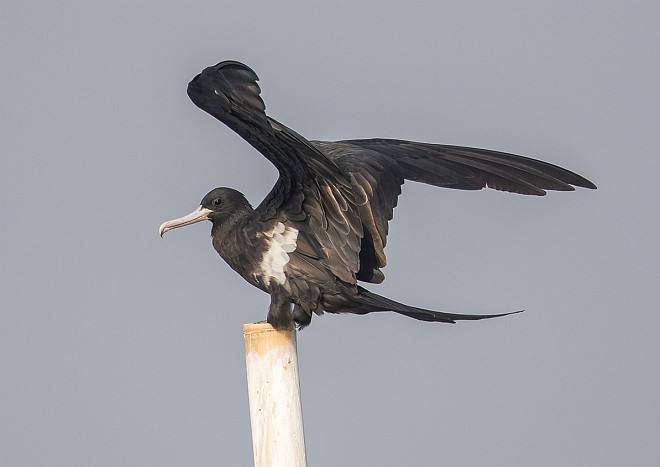Lesser Frigatebird
IUCN
LCBasic Information
Scientific classification
- name:Lesser Frigatebird
- Scientific Name:Fregata ariel
- Outline:Waterfowl
- Family:Suliformes Fregatidae Fregata
Vital signs
- length:77-78cm
- Weight:625-955g
- lifetime:10-16year
Feature
A tireless aerialist
Distribution and Habitat
Origin: Australia, Brazil, British Indian Ocean Territory, Brunei Darussalam, China, Christmas Island, Cocos (Keeling) Islands, Comoros, Fiji, French Polynesia, India, Indonesia, Japan, Kiribati, South Korea, Madagascar, Malaysia, Maldives, Marshall Islands, Mauritius, Mayotte, Federated States of Micronesia, Nauru, New Caledonia, Northern Mariana Islands, Palau, Philippines, Reunion Island, Seychelles, Singapore, Solomon Islands, Sri Lanka, United Republic of Tanzania, Thailand, Timor-Leste, Tonga, United States, United States Minor Outlying Islands, Vanuatu, Vietnam, Wallis and Futuna Islands.
Wandering: Djibouti, Eritrea, Israel, Jordan, Kenya, Mozambique, New Zealand, Oman, and Somalia.
Uncertain: Guam.
They mainly live in tropical oceans and islands in the sea. They usually fly over the sea all day long. They are rarely seen swimming in the sea or walking on the ground. They are tireless flyers.
Appearance
The female white frigatebird is slightly larger. The wings are particularly narrow and long and pointed, the tail is also very long and forked, and the tarsus is very short and feathered. The male is black all over, with a blue-green sheen on the upper body. The feathers on the flap are lanceolate. The lower body is dark black, and the feathers are also lanceolate, with a slight blue-green sheen. The feathers on both sides of the abdomen have white spots. The female is darker than the male, with less black and more brown on the upper body, and less shiny, and the small wing coverts are brown. There is a chestnut collar on the back of the neck. The chest and upper abdomen are white with chestnut red. The forehead, throat, lower abdomen and undertail coverts are black. The armpits are white.
The iris, beak and feet of the male are black, and the female is red; the throat sac and eyelids are red.
The head and upper chest of the young bird are white with rust red, and there is a wide
Details
Lesser Frigatebird, also known as Lesser Frigatebird, has three subspecies.

Lesser Frigatebird is a resident bird, wandering over long distances during some non-breeding seasons. Like other frigatebirds, the white-spotted frigatebird also has pirate habits, often snatching and forcing other seabirds to spit out their captured food, and then grabbing it for themselves. The white-spotted frigatebird is also a living weather instrument. When they rest on the mangroves by the sea, it indicates that a storm is coming. After the weather clears up, they often spread their wings and turn up and down to bask in the sun.
The white-spotted frigatebird mainly feeds on fish, and mainly snatches and forces other seabirds to spit out the fish they catch in a pirate-like manner, and then snatches them away before these foods fall into the sea. They also prey on crabs and other crustaceans on the beach. Sometimes they also prey on squid on the sea surface.
The white-spotted frigatebird breeds on islands in tropical oceans. The breeding season is from May to December. They nest on island trees or bushes, and rarely nest on the ground. The nest is made of plant branches and leaves. Each nest lays one egg, which is white and 60-64 mm × 43 mm in size. The incubation period is about 40 days. The chicks are late-maturing.
Listed in the "Red List of Endangered Species of the World Conservation Union" (IUCN) 2018 ver 3.1-Least Concern (LC).
Listed in the second level of China's "National Key Protected Wildlife List" (February 5, 2021).
Protect wildlife and eliminate game.
Maintaining ecological balance is everyone's responsibility!








